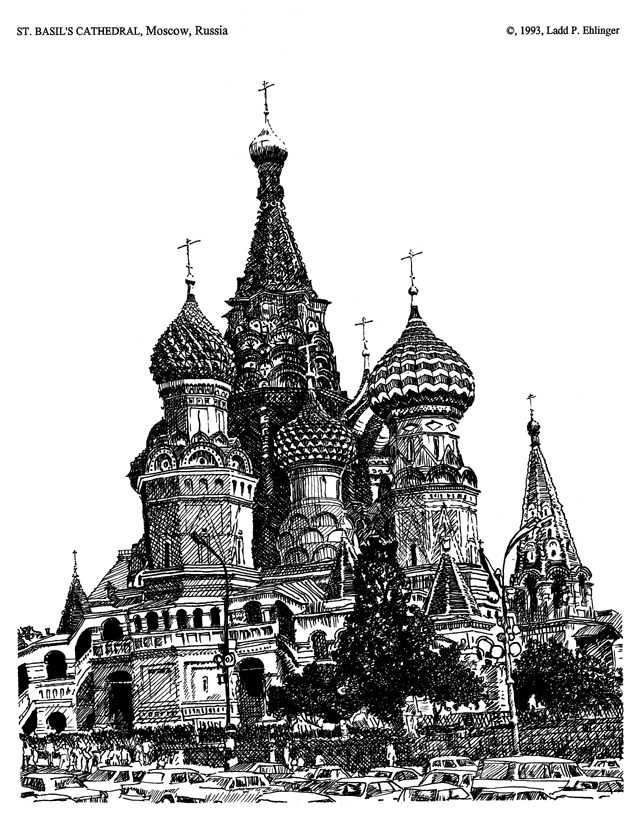
Projects Newsletters Personnel Contact

St. Basil's Cathedral in Moscow is this issue's limited edition signed print by Ladd P. Ehlinger. The cathedral lies on the south side of Red Square at the west end where the trapezoidal (in plan) square narrows and fronts on the Moscow River. The Kremlin is to the north of the cathedral, the G.U.M. department store is to the south, and a museum is to the east,
There are some interesting "factoids" that should be discussed first, before the cathedral itself is discussed.
The name "Red Square" has a completely different connotation in Russian than it has in English. We have been taught by implication that the name Red Square was named for the Red Communists. This simply isn't true. The square was originally ogled Krasnayov in ancient Russian, which has two meanings: beautiful and red. The Russians understand it as beautiful. The name should have been translated into English as "Beautiful Square".
The Kremlin has always been understood by implication to be an evil place, the seat of the communists' government, a la President Ronald Reagan's description of the evil empire. Kremlin actually means fort in Russian. All ancient cities in Russia had a Kremlin, and they were the location picked for a Last ditch defense in a war. The Kremlin in Moscow just happened to be the Tsar's Kremlin as well, containing palaces and multiple churches as well as the necessary governmental buildings.
St. Basil's was built by the Tsar in 1554, to celebrate a military victory over the Tatars, who had oppressed the Russians for centuries. Unlike other Byzantine churches of the Russian Orthodox Church, which are severe and almost depressing in appearance, St. Basil's is festive and celebratory in its forms and shapes and in its colors.
The cathedral has eight onion domes, peculiar bulbous shaped toppings, on top of cylindrical and octagonal drums with clerestory window lighting immediately under the masonry dome concealed within. In plan, St. Basil's has nine square bays in the form of a square, three each way. The sanctuary consists of three of the bays and is forbidden to all but the priests and male elders of the Church, and is separated from the remainder of the bays by a screen.
The Russian Orthodox Church worships icons. Icons are portraits of the Holy Family members or saints of the Church painted on wood and mounted in the masonry walls of the church inside and out, and on the sanctuary screen. The interiors of Russian Orthodox churches Are severe and would be oppressive but for the icons. In any case, the interiors are very simple.
The onion domes are limited to Russian Orthodox churches. They are actually constructed of ribbed frames made of wood, similar to that of a ship, and sheathed in sheet metal that has been deformed and shaped to perform as shingles or like scales of a fish. These sheet metal panels overlap to become watertight. They are painted bright contrasting colors, such as red and green, blue and orange. Some are covered with gold leaf ,
The friezes under the onion domes are fabricated of sheet metal as well, and are perforated to make an interesting shadow pattern.
Since the revolution in 1991, a wealthy person has purchased a number of churches, including St. Basil's, from the Russian government and donated them to the Russian Orthodox Church. Interestingly, little in the way of restoration has to be done to get these buildings back in service as churches, as the communist government maintained them beautifully along with all of the Tsar's palaces since 1917. Today, services are being held in churches all over Russia.